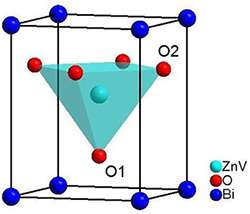A new PbTiO3-type giant tetragonal compound for piezoelectric materials

The solid solution consisting of PbZrO3 and PbTiO3, P(Zr,Ti)O3 (PZT) is the most widely used piezoelectric material due to its excellent piezoelectric properties at morphotropic phase boundaries (MPB) between rhombohedral and tetragonal structures.
There is growing demand for a replacement to PZT because it contains lead-a toxic material. For this purpose, the development of novel lead-free rhombohedral and/or tetragonal polar compounds is crucial.
Now, Yu Runze, Hajime Hojo, Masaki Azuma and colleagues at Tokyo Institute of Technology, and colleagues at Chuo University, and the Japan Atomic Energy Agency have discovered a new PbTiO3-type giant tetragonal compound with the chemical formula Bi2ZnTiO6.
Polycrystalline samples of Bi2ZnVO6 were prepared by high-pressure synthesis at 9 GPa and 1100 oC and crystal structures were investigated by synchrotron X-ray diffraction and transmission electron microscope.
Analysis revealed that Bi2ZnVO6 has a giant tetragonal distortion of c/a = 1.26 and an estimated electrical ionic polarization of 126 μC/cm2. This value of the spontaneous polarization is the largest among PbTiO3-type perovskite compounds.
This polar compound with a large tetragonal distortion is a promising candidate for producing high performance lead-free piezoelectric solid solutions with MPB.
More information: Runze Yu et al. New PbTiO -Type Giant Tetragonal Compound Bi ZnVO and Its Stability under Pressure , Chemistry of Materials (2015). DOI: 10.1021/cm504133e
Journal information: Chemistry of Materials
Provided by Tokyo Institute of Technology



















